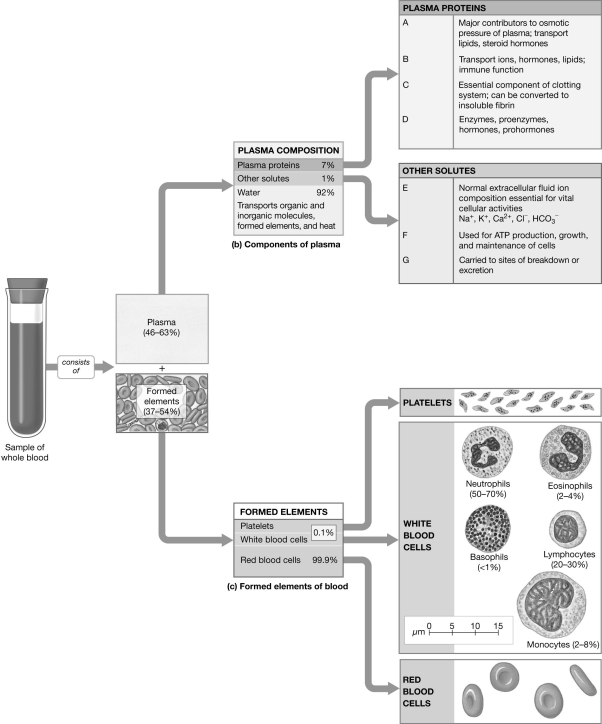A) globulins.
B) transport proteins.
C) albumins.
D) collagen.
E) fibrinogens.
Correct Answer

verified
Correct Answer
verified
Multiple Choice
Which condition(s) may result in an decreased red blood cell count?
A) acute infections
B) leukemia
C) menstruation
D) hypochromic anemia
E) all of the above
Correct Answer

verified
Correct Answer
verified
Multiple Choice
The common pathway of coagulation ends with
A) the sticking of platelets to damaged tissue.
B) the activation of a proenzyme exposed to collagen.
C) the release of tissue factor by damaged endothelium.
D) the activation of a clotting factor that converts prothrombin to thrombin.
E) the activation of a clotting factor that converts fibrinogen to fibrin.
Correct Answer

verified
Correct Answer
verified
Multiple Choice
A person's blood type is determined by the
A) size of the red blood cells.
B) shape of the red blood cells.
C) chemical character of the hemoglobin.
D) presence or absence of specific molecules on the plasma membrane.
E) number of specific molecules on the plasma membrane.
Correct Answer

verified
Correct Answer
verified
Multiple Choice
Bill wants to determine his blood type, so he takes a few drops of blood from a puncture wound in his finger and mixes it with various antisera. His blood cells agglutinate when mixed with the anti-A sera and anti-Rh sera, but not with the anti-B sera. This means
A) Bill could receive type B blood in a transfusion.
B) Bill could donate blood to an individual with type AB blood.
C) Bill is Rh-positive.
D) Bill's plasma contains anti-B antibodies.
E) Bill's plasma would cross-react with type 0 negative red blood cells.
Correct Answer

verified
Correct Answer
verified
Multiple Choice
Another term for the condition known as erythroblastosis fetalis is
A) sensitization incompatibility.
B) cross reaction.
C) hemolytic disease of the newborn.
D) anemia.
E) none of the above
Correct Answer

verified
Correct Answer
verified
Multiple Choice
EPO is released when
A) oxygen levels in the blood increase.
B) oxygen levels in the blood decrease.
C) carbon dioxide levels in the blood increase.
D) carbon dioxide levels in the blood decrease.
E) protein levels in the blood increase.
Correct Answer

verified
Correct Answer
verified
Multiple Choice
Type AB blood contains
A) A agglutinins on the red blood cells.
B) agglutinogen A and B.
C) B agglutinogens on the red blood cells.
D) B agglutinins in the plasma.
E) agglutinin A and B.
Correct Answer

verified
Correct Answer
verified
Multiple Choice
Which of the following is a necessary cofactor in the formation of a blood clot?
A) albumin
B) fibrinogen
C) calcium
D) prothrombin
E) vitamin K
Correct Answer

verified
Correct Answer
verified
Multiple Choice
The following is a list of the steps involved in the process of hemostasis and clot removal: 1. coagulation 2) fibrinolysis 3) vascular spasm 4) retraction 5) platelet phase The correct sequence of these steps is
A) 5, 1, 4, 2, 3.
B) 3, 5, 1, 4, 2.
C) 2, 3, 5, 1, 4.
D) 3, 4, 5, 2, 1.
E) 4, 3, 5, 2, 1.
Correct Answer

verified
Correct Answer
verified
Multiple Choice
________ occur(s) where endothelial and smooth muscle cells contain large quantities of lipids.
A) Clots
B) Emboli
C) Coagulation
D) Plaques
E) Stasis
Correct Answer

verified
Correct Answer
verified
Short Answer
The percentage of whole blood occupied by cellular elements is termed the _________________________.
Correct Answer

verified
Correct Answer
verified
Multiple Choice
Placement of an oxygen mask on a patient could result in
A) anemia.
B) increased numbers of lymphocytes.
C) increased erythropoiesis.
D) decreased erythropoiesis.
E) decreased elimination of vitamin K.
Correct Answer

verified
Correct Answer
verified
Multiple Choice
________ are large phagocytic WBCs that are "transformed" into phagocytic macrophages at the site of an injury.
A) Neutrophils
B) Eosinophils
C) Basophils
D) Lymphocytes
E) Monocytes
Correct Answer

verified
Correct Answer
verified
Short Answer
 -Label F: ________
-Label F: ________
Correct Answer

verified
Correct Answer
verified
Multiple Choice
Stem cells responsible for the production of white blood cells originate in the
A) liver.
B) thymus.
C) spleen.
D) bone marrow.
E) lymphoid tissue.
Correct Answer

verified
Correct Answer
verified
Multiple Choice
Which of the following is the MOST active phagocytically?
A) neutrophils
B) eosinophils
C) basophils
D) lymphocytes
E) erythrocytes
Correct Answer

verified
Correct Answer
verified
Multiple Choice
Thrombocytopenia is a deficiency of
A) antibodies.
B) erythrocytes.
C) platelets.
D) WBC.
E) all of the above
Correct Answer

verified
Correct Answer
verified
Multiple Choice
A person who lives in a city at sea level and vacations in the Rocky Mountains would experience an increase in
A) the number of platelets in the blood.
B) the number of lymphocytes in the blood.
C) red blood cell count.
D) white blood cell count.
E) the density of the bone marrow.
Correct Answer

verified
Correct Answer
verified
Short Answer
The most common type of WBC in a normal blood sample is the _________________________.
Correct Answer

verified
Correct Answer
verified
Showing 61 - 80 of 80
Related Exams